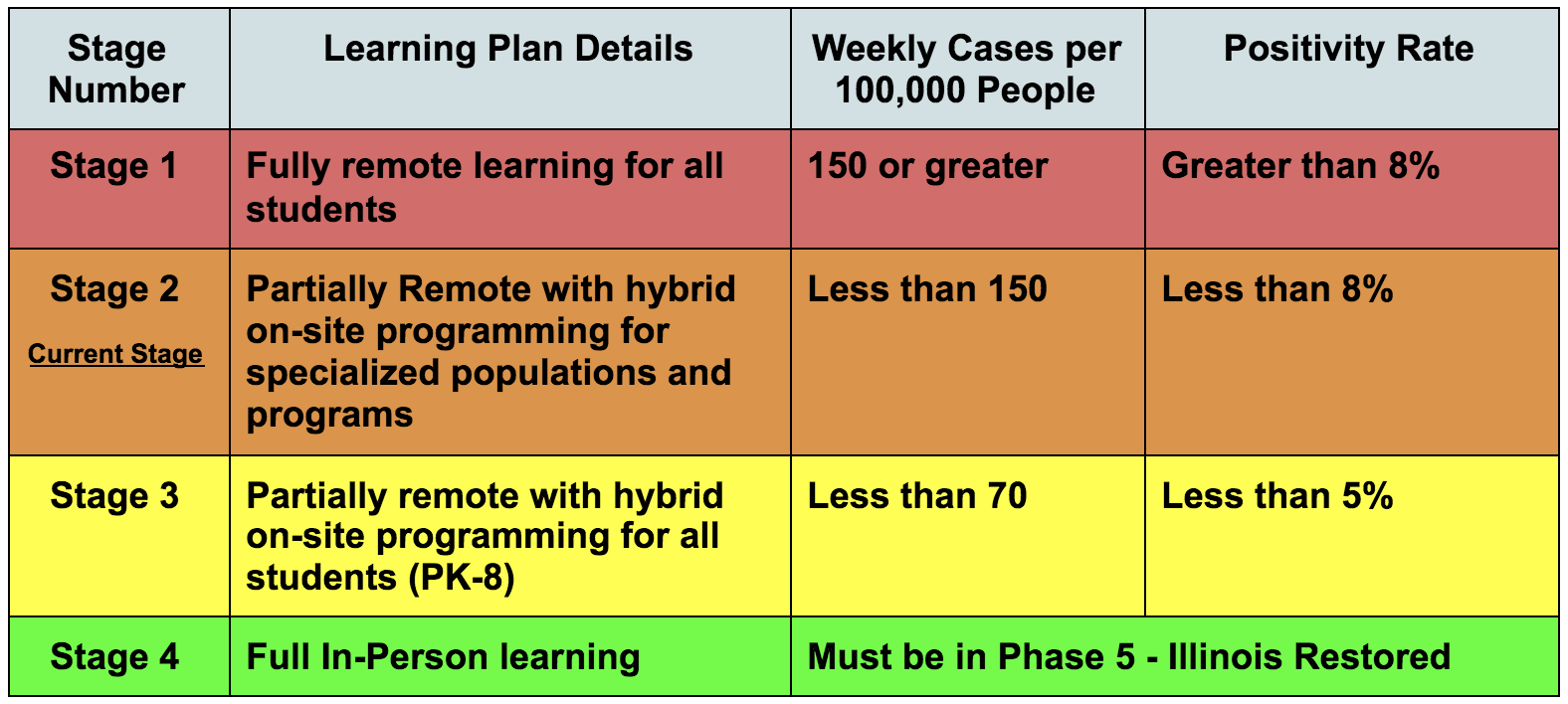Dear District 97 Community
First, I want to thank all of you for your patience and understanding as we work through the challenges of this unprecedented school year. I also want to express my sincere gratitude for each and every staff member, parent, guardian, relative and childcare provider who has supported our students with remote learning during the past four weeks. I know it hasn’t been easy, but I want you to know that we appreciate you and value your partnership.
While we have been working very hard to improve the remote learning experience for students, we have also been focused on developing and implementing a phased attendance approach that prioritizes the health and safety of our students and staff. This approach is based on a guiding set of metrics, which includes the weekly case count and positivity rate in our region. The rest of this update will provide an overview of these metrics and our plans to transition groups of students to on-site programming in the coming weeks.
District 97 Metrics for Decision-Making
Our goal is to safely return District 97 students and staff to on-site learning by following a plan that is flexible and responsive to the changing conditions of the pandemic. We believe that we can achieve our goal by instituting a phased attendance approach. Click here to view the D97 Guiding Metrics for a Phased Attendance Model, which details the data that will help inform our decisions and planning moving forward.
Metrics Chart

Click here to check the current weekly cases per 100,000 people.
Click here to check the current positivity rate.
*Remember to refresh the screen to update the results.
Stage 2 - Phased Attendance Approach
Favorable metrics over the past few weeks allowed District 97 to move into Stage 2 of our plan—partially remote with hybrid onsite programming for specialized populations. Finding ways to best serve all of our students equitably during remote learning poses a challenge; especially for students with Individualized Education Programs (IEPs) and others most vulnerable. The Illinois State Board of Education (ISBE) emphasized that this group should be given the highest priority when considering which students will return to in-person learning.
Stage 2 has the following groups and associated services:
- Group 1: Students who require intensive level of special education support
- Group 2: Students who require a moderate level of special education support
- Group 3: Students who require tiered support relative to academic achievement, social emotional learning and/or engagement
On Sept. 15, a small group of students in the district’s multi-needs program began receiving on-site instruction, interventions and support at Julian Middle School. We are currently determining the logistics for bringing the next group of students (IEPs requiring 1:1 support and Early Childhood Special Education) onsite—tentatively by early October. The remaining groups associated with Stage 2 will be phased in after we ensure that there are no issues related to the health and safety of our students and staff.
Stage 3 and Next Steps
We understand that our families, students and staff are eager for more information about when our district will transition to a hybrid model for all students (Stage 3). Although we have not yet identified a specific date, our planning team will be working toward achieving this goal by Trimester 2 as part of our phased attendance approach.
Next steps include:
- Monitoring metrics to determine when we can safely transition to Stage 3.
- Collecting data from staff and families to inform our transition plans. On Wednesday, a survey was sent to all staff, and we plan to send a survey to families in early October to determine learning preferences for each student should the district move to a hybrid learning model.
- Updating our hybrid learning plans in collaboration with our unions.
- Revising hybrid learning guides/FAQs for staff and families, based on the most up-to-date guidance from ISBE, the Illinois Department of Public Health and others.
We are encouraged by the downward trend in our guiding metrics over the past two weeks. Continuing this trend as a community is an essential component of implementing transitions to on-site learning and keeping our schools open. We all play an important role in controlling community transmission, so we are asking everyone to continue following IDPH guidelines. Wearing face coverings, practicing social distancing, limiting mass gatherings and using proper hand hygiene all play a role in protecting the overall health of our community.
Finally, please remember that changing public health conditions and other operational variables may impact our timeline. With that said, all of our decisions will continue to be guided by our three priorities: the health and safety of our students and staff; providing consistent, high-quality learning experiences; and our commitment to equity.
Thank you for taking the time to read through this lengthy update, and thank you again for all you are doing. With all that has happened in 2020, I don’t think there has been a more challenging time to be an educator or a parent. I want you to know that we are here for you and want to do everything we can to support your health and well-being. Our amazing social workers have put together a list of resources, which may be helpful to you and your students. I will also be scheduling virtual coffees over the next few months to connect with families and staff; my first is Wednesday, Sept. 30, at 10 a.m. I look forward to talking with you soon.
Sincerely,
Dr. Carol Kelley
Superintendent
Contact Us through Let’s Talk
